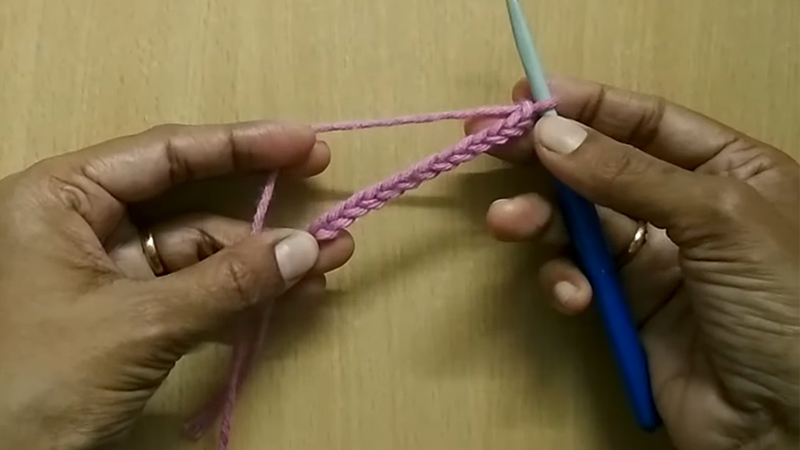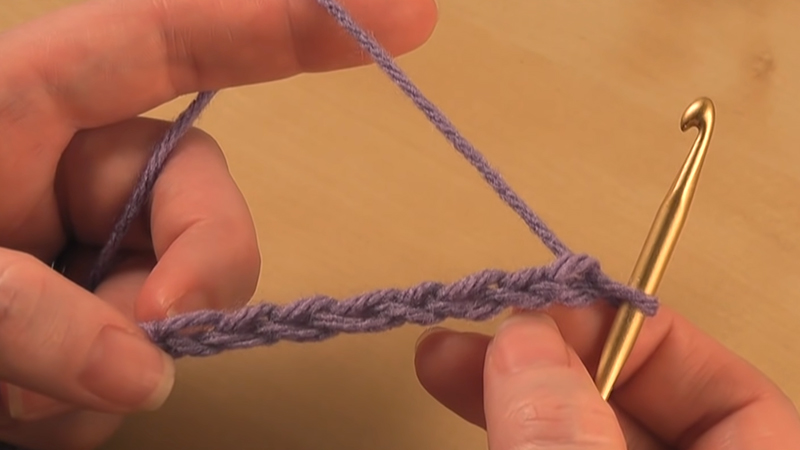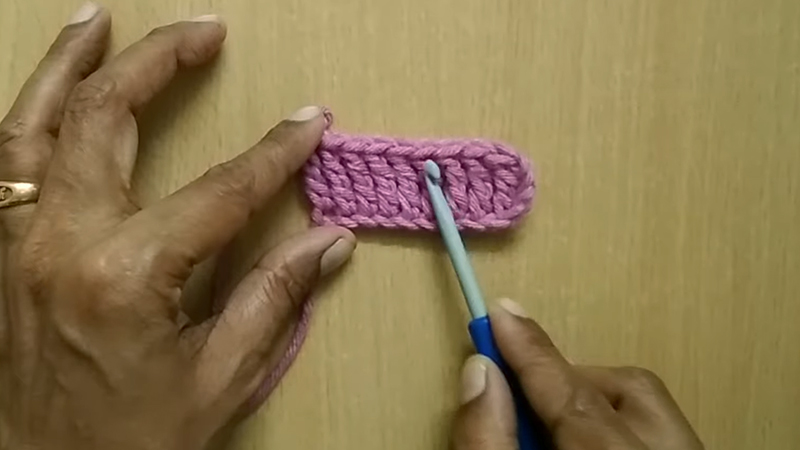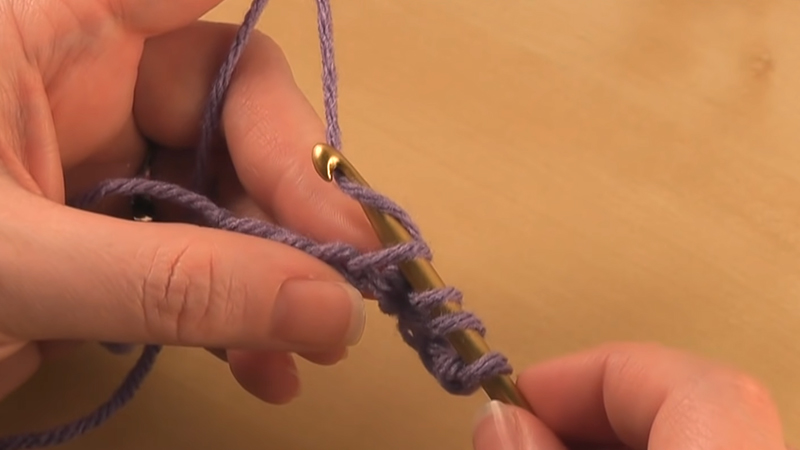The treble crochet stitch, abbreviated as tr or trc, is a fundamental technique in crochet that offers versatility and texture to your projects. It stands out for its height, creating a looser and more open fabric than its shorter counterparts.
This stitch is a staple in the crocheter’s repertoire, ideal for various projects, from airy shawls and blankets to intricate lacework.
Mastering the treble crochet opens up opportunities for creating visually captivating patterns and allows for faster progress on larger projects.
This guide will delve into the step-by-step process of executing the treble crochet stitch, providing you with the skills to incorporate it into your crochet endeavors.

What Is a Treble Crochet Stitch?
The treble crochet stitch, often abbreviated as tr or trc, is a fundamental technique in crochet. It’s characterized by its height, creating a looser and more open fabric than single or double crochet.
To execute a treble crochet, yarn over twice, insert the hook into the stitch, yarn over and pull through (resulting in four loops), yarn over and pull through two loops, yarn over and pull through two more loops, and finally, yarn over and pull through the remaining two loops.
This stitch is versatile and widely used in various projects, from blankets and scarves to intricate lacework.
Its height makes it an excellent choice for creating patterns with a sense of drape and flow, and it’s an essential skill for crocheters looking to expand their repertoire.
How to Treble Crochet Stitch? Step-By-Step Guide
The treble crochet stitch, often abbreviated as tr or trc, is a fundamental crochet stitch that creates a taller and looser fabric than single or double crochet.
It’s a versatile stitch used in various crochet projects, from scarves and blankets to garments and accessories.
Here’s a step-by-step guide on how to execute the treble crochet stitch:
Materials Needed:
- Yarn.
- Crochet Hook.
Step-by-Step Instructions:
Make a Foundation Chain
Begin by creating a slip knot, and securing it onto your crochet hook. With the hook, yarn over and pull through, forming the first chain.
Continue this process, forming a chain of stitches. This foundation chain sets the width of your project and serves as the starting point.
Yarn Over Twice
Hold the working yarn behind the hook. Wrap it around the hook from back to front, then repeat this motion.
This creates two loops around the hook. This initial ‘yarn over’ step is unique to the treble crochet, making it taller than other basic stitches.
Insert Hook
Guide the hook through the chosen stitch, ensuring it passes smoothly without catching or splitting the yarn.
The motion should be fluid, from front to back, capturing both stitch loops. A clean entry sets the stage for a well-formed treble crochet.
Yarn Over and Pull Through
Perform another yarn over, wrapping the yarn around the hook. Then, draw the yarn through the stitch. This action adds to the loops on your hook, now totaling four. Maintain an even tension to prevent the stitch from becoming too tight or loose.
Yarn Over and Pull Through Two Loops
Continue by yarn over and pull the yarn through the first two loops on your hook. This process reduces the number of loops on the hook from four to three, and it’s a critical step in the treble crochet stitch.
Yarn Over and Pull Through Two Loops Again
Once again, yarn over and draw the yarn through the next two loops on your hook. This action leaves you with only two loops remaining. Keep a steady rhythm to maintain even tension.
Yarn Over and Pull Through the Final Two Loops
With two loops remaining on the hook, yarn over one more time. Gently pull the yarn through the last two loops. This concluding movement finalizes the treble crochet stitch. Ensure this pull-through is smooth and steady, creating a clean finish to the stitch.
Complete the Stitch
Congratulations! You’ve successfully executed a treble crochet stitch. Take a moment to admire your work – it should be noticeably taller and more open than single or double crochet stitches. This stitch is a versatile foundation for various crochet projects.
Continue Across the Row
Repeat steps 2 through 8 for each stitch in the row. Remember to begin each new treble crochet with two initial yarnovers. Maintain consistency in your tension and motion to create an even fabric.
Turn Your Work
Upon reaching the end of the row, gently turn your work. This action positions your project for the next row. Ensure it lies flat and is not twisted. Turning your work is a fundamental step in crochet, allowing you to build upon the previous rows.
What Projects Are Suitable for Treble Crochet Stitches?

Treble crochet stitches are versatile and can be used in various projects.
Here are some examples of projects that are particularly well-suited for treble crochet:
Blankets and Afghans
Treble crochet stitches are fantastic for blankets and afghans due to their height. They allow for quicker progress and create a beautifully textured, warm fabric. This makes them ideal for cozying up on colder days or as a thoughtful gift.
Lace Shawls and Wraps
The height and openness of treble crochets lend themselves perfectly to lace patterns. This results in delicate, airy, elegant, and functional shawls and wraps, making them a lovely accessory for special occasions or everyday wear.
Scarves and Cowls
Treble crochet stitches provide an excellent drape, ideal for scarves and cowls. Their versatility allows for various styles, from lightweight, lacy scarves to snug, textured cowls. They’re perfect for adding a touch of warmth and style to any outfit.
Summer Tops and Dresses
The breathable fabric created by treble crochets makes them an excellent choice for warm-weather garments. Tops and dresses made with treble crochet stitches are comfortable, stylish, and perfect for staying cool on hot days.
Tablecloths and Doilies
Treble crochet stitches can create intricate and delicate lace patterns, making them ideal for tablecloths and doilies. These decorative items add a touch of elegance to any dining or living space.
Market Bags
The sturdiness and quick work-up of treble crochet stitches make them perfect for market bags. These durable bags can carry groceries, books, or any essentials, and their handmade charm adds a personal touch to your everyday routine.
Ponchos and Wraps
Treble crochet stitches can create stylish and versatile shawls and wraps. The drape of the fabric makes them comfortable to wear, and they can be layered over various outfits for a chic look.
Baby Blankets
Treble crochet stitches create a soft, textured fabric that’s gentle on a baby’s delicate skin. These blankets are practical for keeping little ones warm and making cherished keepsakes.
Benefits of Using a Treble Crochet Stitch

A treble crochet stitch can create fast and airy projects, such as shawls, scarves, blankets, and lace. It can also be combined with other stitches to create interesting textures and patterns.
Using a treble crochet stitch in your crochet projects offers several benefits:
Speed
Treble crochet is taller and covers more ground with each stitch, making it a faster stitch to work up. This can be particularly advantageous when working on larger projects where you want to progress quickly.
Height
The treble crochet creates a taller stitch compared to single or double crochet. This added height helps achieve an open and airy texture in your projects, ideal for lacy and lightweight designs.
Versatility
Treble crochet can be used in various projects, from blankets and shawls to garments and accessories. Its versatility allows you to create different textures and patterns within your work.
Drape
Because of its height and openness, treble crochet fabric has a lovely drape, making it suitable for cardigans, shawls, and dresses. The stitch allows the fabric to flow gracefully, providing a flattering fit.
Variation
You can create unique and intricate designs by combining treble crochets with other stitches. Mixing treble crochet with single or double stitches can create beautiful textured patterns.
Breathability
The taller stitches in treble crochet create more open spaces in the fabric, making it breathable and suitable for warm-weather garments and accessories.
Quick Coverage
When you need to cover a large area in your project efficiently, such as in a blanket, using treble crochet can help you complete your work more quickly than with shorter stitches.
Common Mistakes to Avoid When Making a Treble Crochet Stitch

When making treble crochet stitches, beginners and even experienced crocheters can encounter common mistakes.
To achieve clean and precise treble crochet stitches, here are some mistakes to avoid:
Uneven Tension
- Problem: Inconsistent tension can result in stitches that are too tight or loose, leading to an uneven fabric.
- Solution: Practice maintaining a consistent yarn tension. Comfortably hold the yarn and keep the same tension throughout your work.
Forgotten Initial Yarn Overs
- Problem: Forgetting one or both initial yarnovers can lead to shorter stitches and an inconsistent appearance.
- Solution: Pay close attention to the steps in creating a treble crochet. Remember to yarn over twice before inserting the hook into the stitch.
Skipping Stitches
- Problem: Accidentally skipping a stitch can decrease the number of stitches, leading to an uneven project.
- Solution: Take your time when inserting the hook into the stitch. Ensure that you go through both stitch loops to avoid skipping any.
Yarning Over Incorrectly
- Problem: Yarning over in the wrong direction can create twisted or messy stitches.
- Solution: Always yarn over from back to front when making treble crochet stitches. This ensures that the yarn wraps around the hook correctly.
Incomplete Yarn Overs and Pull-Throughs
- Problem: Failing to complete all the necessary yarnovers and pull-throughs can result in incomplete or uneven stitches.
- Solution: Double-check that you’ve completed each step of the treble crochet stitch. This includes the initial yarnovers, inserting the hook, and pulling through loops.
Losing Count
- Problem: Losing track of your stitch count can lead to irregular edges and malformed projects.
- Solution: Count your stitches at the end of each row. If you find the count is off, carefully review your work to identify and correct any mistakes.
FAQs
Can I use the treble crochet stitch for amigurumi projects?
While the treble crochet creates a looser fabric, it’s less commonly used in amigurumi. Single crochet is preferred for its tight, dense finish, which helps shape.
What’s the difference between a treble crochet and a double crochet?
The treble crochet is taller than a double crochet, requiring an extra yarn over and pull-through steps. This creates a more open and elongated stitch.
Can I use the treble crochet in combination with other stitches?
Absolutely! Combining treble crochets with other stitches, like single and double crochets, can create intricate textures and patterns.
Is the treble crochet stitch suitable for beginners?
While it’s slightly more advanced than basic stitches, beginners can undoubtedly learn the treble crochet with practice. Starting with a small project or swatch can help build confidence.
Why does my fabric look uneven even though I’m following the instructions?
Uneven tension or skipped stitches can cause this issue. Pay attention to consistent yarn tension and ensure you work into every stitch.
Wrap Up
Mastering the treble crochet stitch is a valuable skill for any crochet enthusiast. Its height, versatility, and ability to create an open and airy fabric make it an essential addition to your repertoire.
By following the step-by-step guide, you can confidently execute treble crochet stitches in your projects, whether crafting blankets, garments, or intricate lacework.
Remember to practice consistently and pay attention to detail, leading to clean, precise stitches.
Embrace the creativity and flexibility that the treble crochet stitch offers, and let it elevate your crochet projects to new levels of artistry and craftsmanship.
Leave a Reply